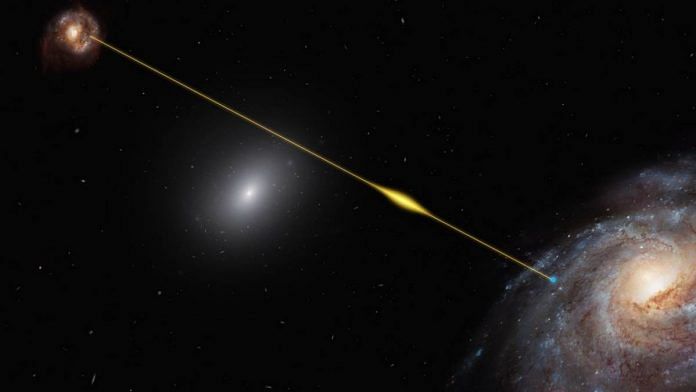Bengaluru: An international team of astronomers working on China’s Five-hundred-meter Aperture Spherical Radio Telescope (FAST) has detected a new fast radio burst (FRB) with unusual properties.
The repeating signal is also associated with and accompanied by a persistent source, which is causing the location to emit in the radio frequency continuously. The analysis and follow-up observations were published as a paper in the journal Nature this week.
The signal, named FRB 190520B by standard convention, is being emitted from a dwarf galaxy 3 billion light years away, and the findings closely mirror observations made of another previously recorded FRB from 2012.
The discovery provides insights into the formation and evolution of fast radio bursts, which are some of the most extremely energetic phenomena in the universe, lasting mere milliseconds.
Fast radio bursts and repeaters
Fast radio bursts were first detected in 2007, and hundreds have been observed since. They are high-energy phenomena, emitting electromagnetic energy in the form of bursts of radio pulses. These last for an interval ranging from a mere fraction of a millisecond to a few milliseconds. In each pulse, the source can emit as much energy as the sun does in a month.
FRBs are triggered by explosive events in the universe, such as a supernova or the collision of two compact objects like a neutron star and a black hole. Such bursts typically occur as a transient flash only once, never to be seen again. A majority of FRBs occur this way.
Once or twice a year, astronomers also observe repeated bursts, where the signals recur with a certain frequency over a period of time, spanning hours to days, sometimes even over a period of months. Such signals are believed to be produced typically by magnetars — rapidly spinning neutron stars, which are themselves left over, extremely dense remnants of dead stars that exploded in a supernova.
The new signal is a repeating one that’s produced by a magnetar in a dwarf galaxy located three billion light years away from Earth.
FRB 190520B
The signal was first observed on 20 May, 2019. Four bursts were detected within the first 24 seconds, and in follow-up observations taken monthly. In the middle of 2020, 75 bursts were detected in under 19 hours.
Along with the repeating signal, scientists have also observed a persistently weak and fuzzy emission of radio waves from the source location, making this FRB signal highly unusual.
This effect was observed previously in the 2012 FRB 121102, which was ultimately theorised to be from a neutron star, or a magnetar that’s near a powerful magnetic field like that of a black hole, or a magnetar embedded within a nebula — the swirling colourful cloud of interstellar dust and gas.
The current signal is “co-located with a compact, persistent radio source and associated with a dwarf host galaxy of high specific-star-formation rate”, similar to a 2020 signal named 20201124A, which was present in a star-forming region, with other sources of radio emission.
While FRB 121102 “turns off” for months, going silent and then resuming activity, the current signal, FRB 190520B, is the only one known to be continuously and persistently active.
Additionally, the signal from the FRB 190520B point source was also observed to be undergoing a twisting distortion called plasma dispersion. Such an effect occurs when the signal passes through superheated plasma, under a strong magnetic field.
Since hot plasma like this is typically produced in supernova explosions, the astronomers concluded that the current FRB source still seems to be embedded in its own progenitor star’s remains, within its natal environment after a supernova explosion, without the remaining material having been cleared out.
Insights and further questions
The observations provide insights into one of the least understood astronomical phenomena of all time, FRBs.
Since a majority of FRBs are transient, they are hard to study and predict. Among repeating bursts too, sources are hard to pinpoint, with only a couple being identified as coming from magnetars.
Most FRBs occur outside our galaxy. The only one spotted within the Milky Way was also traced to a previously known magnetar.
The new findings represent a new scenario, now observed in two cases, where a fast radio burst co-exists with a persistent radio source. Astronomers speculate that when the plasma and surrounding material clear away, the persistent signal is likely to disappear.
However, while they provide new clues, the findings also raise questions such as how frequently FRBs co-exist with persistent radio sources, and how and when such combinations can be found.
(Edited by Poulomi Banerjee)
Also read: Scientists capture first-ever image of supermassive black hole at the centre of Milky Way



